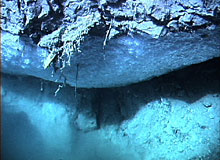
Methane gas hydrate forming below a rock overhang at the sea floor on the Blake Ridge diapir. This image, taken from the DSV Alvin during the NOAA-sponsored Deep East cruise in 2001, marked the first discovery of gas hydrate at the sea floor on the Blake Ridge. Methane bubbling out of the sea floor below this overhang quickly “freezes.” forming this downward hanging hydrate deposit, dubbed the "inverted snowcone." Click image for larger view.
Windows to the Deep
Exploration of the Blake Ridge
July 22 – August 3, 2003
On this exploration, scientists used the Alvin submersible and other tools to explore the biology, physics, and chemistry of sea-floor methane seeps at water depths of 2,000 m to 2,800 m off the coast of the southeastern United States. These seeps occur where methane hydrate deposits—a solid form of methane and water stable at high pressures and low temperatures—rise to shallow depths beneath the sea floor and break down to produce methane gas. The Alvin dives explored three sea-floor features where scientists found chemosynthetic communities that live on or near the sea-floor emission sites.
Background information for this exploration can be found on the left side of the page. Daily updates and more detailed logs and summaries of exploration activities are posted below and to the right.
Updates & Logs
Click images or links below for detailed mission logs.
 August 1, 2003 Have you heard of organic carbon that microbes degrade to make methane? Join the search!
August 1, 2003 Have you heard of organic carbon that microbes degrade to make methane? Join the search! July 31, 2003 The young science party consists mainly of graduate and undergraduate students. Read about a first Alvin dive experience in today's log.
July 31, 2003 The young science party consists mainly of graduate and undergraduate students. Read about a first Alvin dive experience in today's log. July 30, 2003 The crew returns to the Blake Ridge Diapir in search of Ice Shrimp and Gas Hydrate. They also experience the strong smell of hydrogen sulfide gas.
July 30, 2003 The crew returns to the Blake Ridge Diapir in search of Ice Shrimp and Gas Hydrate. They also experience the strong smell of hydrogen sulfide gas. July 29, 2003 The crew has completed the first dive ever on the Cape Fear Diapir. Near the landing site, divers encountered the most biologically diverse location of the day.
July 29, 2003 The crew has completed the first dive ever on the Cape Fear Diapir. Near the landing site, divers encountered the most biologically diverse location of the day. July 28, 2003 Discovery of a new species of polychaete worm at the Blake Ridge seeps.
July 28, 2003 Discovery of a new species of polychaete worm at the Blake Ridge seeps. July 27, 2003 Dive two at Blake Ridge Diapir yielded, “Waves of clams as far as we could see.”
July 27, 2003 Dive two at Blake Ridge Diapir yielded, “Waves of clams as far as we could see.” July 26, 2003 The next two dives will occur at the Blake Ridge Diapir, a site known for its concentration and diversity of seep organisms, hydrate, and other features such as bacterial mats.
July 26, 2003 The next two dives will occur at the Blake Ridge Diapir, a site known for its concentration and diversity of seep organisms, hydrate, and other features such as bacterial mats. July 25, 2003 The first Alvin dive is complete. This was the first dive ever along the northeastern eroded flank (side) of Blake Ridge.
July 25, 2003 The first Alvin dive is complete. This was the first dive ever along the northeastern eroded flank (side) of Blake Ridge. July 24, 2003 Learn about dive preparations and the first dive on Blake Ridge, where mysterious mounds on the seafloor have yet to be explained.
July 24, 2003 Learn about dive preparations and the first dive on Blake Ridge, where mysterious mounds on the seafloor have yet to be explained. July 23, 2003 After passing through a squall, the science party makes preparations for tomorrow's first dive on Blake Ridge.
July 23, 2003 After passing through a squall, the science party makes preparations for tomorrow's first dive on Blake Ridge.


















